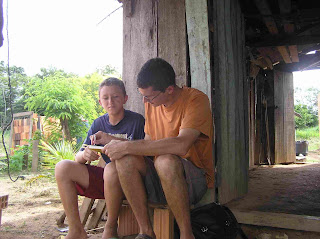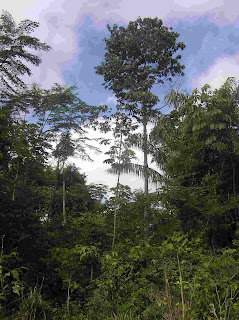Well after six days I'm back from the farm. It was a lot of very relaxing fun, and now i have a better idea of how many of the families sustain themselves, and
The first photo is of me in my office. Working. Hard. Playing mandolin that is...this is where I would spend three or four hours every afternoon after the morning's activities, when it was too hot, usually, i'd take a nap after lunch, and then play mandolin for an hour or two and then work on the computer for about the same amount of time, typing up notes, working on interview protocols etc...

ok, here's a serious photo of me working...something i didn't learn at home: how to dekernel corn for the frangos (chickens). Hint use a cob or you'll get wicked blisters!

and here's the one of me doing the work that is in my genes!

which wouldn't be helpful without my young assistant "Edennias", who has been very helpful in spelling out plant names and identifying trees, and laughing at my pronunciation...

It was very beautiful out there on the farm (photo taking this morning at sunrise, which one sees when one goes to "hammock" at 8:30)

So...the other question i get from y'all is how's the research coming...well as my adviser says "It's complicated". I'm finding some very interesting stuff related to selective fire practices, tree plantings, forest preservation/deforestation, livelihood strategies, and identity production...all of which is to say it's complicated....for example (they say a picture is worth a thousand words) below is a photo of a castanhera stump in the midst of a banana grove...a relic of forest clearing at some point (it's been very difficult to figure out what burning occured where, and what effect each burning cycle had...a subject for later research)

anyways, these trees are massive and particularly striking over the generally deforested landscape. But what they tell me, their existence within this semi-deforested/secondary forest growth mosaic, is that living trees such as the one below were/are purposefully protected during burning cycles (they use burning to clear the secondary growth selectively so that they can plant the grass seed that the cattle feeds on)

However, it's not just isolated trees, there are pretty significant sections of "natural" forest. However X 2, as us environmental anthropologists tend to point out, "nature" is a cultural production, and forest fragments like this are a product of specific cultural practices, i.e burning or not burning, or burning selectively...

Although fragments in a mosaic, these sections of forest do harbor significant biodiversity, as evidenced by this photo I took of some scarlet macaw and some toucans below (the monkey was too quick for my camera, and unfortuntately the wild cat wasn't quick enough for the gun of the owner of the chickens it had eaten!)



besides the "ecological" import of harboring biodiversity, these forest fragments are also important as they provide land cover, and play a role in carbon sequestration...and providing yummy fruit, such as this birimba


So it was an interesting trip....although I'm not sure I'd agree we're in the dry season....but I guess cultural relativism...right?

Speaking of cultural relativism...anyone hungry for dinner? How about some fresh piranha?

Din din was caught on a little fishin trip we took down to the rio...here's a photo inside the casa of the troops getting ready.Anyone know that old time blue grass tune, goes a little something like..."you gotta line I gotta pole darling...." well, here it is

on the way down to the rio...

and Andre proud of his catch (let's just say it was a good thing I wasn't solely responsible for catching dinner; gringo=0, locals=many)

and a parting shot...papaya with rainbow

No comments:
Post a Comment